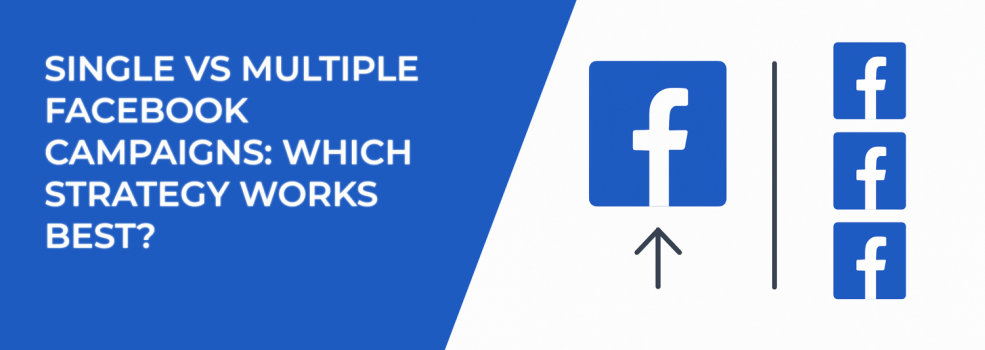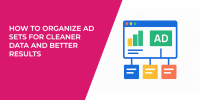Running Facebook Ads can feel like a balancing act. Should you concentrate on a single campaign and refine it until it performs at its peak, or spread your budget across multiple campaigns to test different angles? Both strategies have clear benefits, but the right choice often depends on your budget, your goals, and your stage of growth.
Marketers sometimes jump too quickly into one approach without considering the bigger picture. A single campaign can drive focus and efficiency, but multiple campaigns can open doors to testing and scaling. The key is knowing which one fits your current situation.
Let’s break it down.
The Case for a Single Facebook Campaign
A single campaign works best when simplicity is the priority. By pouring all your ad spend into one place, you give Facebook’s algorithm more data to optimize faster. This helps you generate results sooner and with less waste.
Many advertisers — especially those working with small budgets — choose this path because it keeps things manageable. One campaign can carry the full weight of your marketing effort if you structure it correctly.
Why advertisers choose one campaign
-
Stronger optimization — more conversions and clicks feed into a single campaign, speeding up the learning phase.
-
Reduced audience overlap — fewer risks of bidding against your own ads.
-
Simpler tracking — straightforward reporting makes it easier to see what’s working.
Each of these points ties back to efficiency. With fewer moving parts, you can focus on refining your creative, your targeting, and your offer without juggling multiple dashboards at once. If you’re worried about limited delivery or campaign warnings, you might also find it useful to read about why Facebook shows “Ad Set May Get Zero” and how to fix it.
Example scenario:
Imagine you’re a local gym promoting a new membership package. You only have $40 per day to spend. Splitting that across multiple campaigns would starve each one of data, slowing optimization. By concentrating on one campaign, Facebook gathers signals faster, which leads to cheaper leads and more sign-ups.
When to go with one campaign
-
Your daily budget is under $100.
-
You’re targeting a local or niche audience.
-
You’re promoting one main product or service.
-
You’re new to Facebook Ads and need a clean performance baseline.
These situations often call for focus. Instead of spreading your spend too thin, you allow the algorithm to gather enough information to make smart adjustments.
Pro tip: If you stick to a single campaign, create multiple ad sets within it. That way, you can still test audiences and placements without adding unnecessary complexity.
The Case for Multiple Facebook Campaigns
On the other hand, multiple campaigns can give you flexibility that one campaign cannot. With more campaigns, you can test different objectives, segment your audiences, and spread your risk. This strategy is especially powerful once you’ve grown past the “testing phase” and need to scale.
The real advantage is separation. Each campaign can serve a distinct purpose, making reporting clearer and strategy more structured.
Advantages of multiple campaigns
-
Audience segmentation — you can separate cold traffic, warm leads, and past buyers, sending each group a message that fits their stage of the funnel.
-
Creative testing — different campaigns allow you to compare videos, carousels, and static images without muddying results.
-
Objective clarity — one campaign focuses on conversions, another on traffic, another on engagement — no mixed signals.
-
Budget control — you can shift spend into the campaigns that are delivering the strongest returns.
This setup allows you to scale without confusion. Rather than running everything inside one large campaign, you break things down into manageable pieces. If you’re not sure which objectives to prioritize, check out this guide on Meta Ad Campaign Objectives Explained.
Example scenario:
An online fashion brand spends $1,500 per month on Facebook Ads. Their structure looks like this:
-
A prospecting campaign that targets broad interests and lookalikes.
-
A retargeting campaign for people who viewed products but didn’t purchase.
-
A loyalty campaign with discounts for repeat customers.
Each campaign has a specific role. Together, they create a well-rounded funnel that captures new buyers, brings back undecided visitors, and rewards loyal customers.
When multiple campaigns make sense
-
Your ad spend is at least $500–$1,000 per month.
-
You’re testing several offers, funnels, or creatives.
-
You want clean reporting separated by audience type.
-
You’re in a scaling phase and need more control.
If your business is at this stage, one campaign probably won’t cover everything. Splitting into multiple campaigns allows you to grow strategically without losing sight of what’s working.
Pro tip: Resist the urge to create six or seven small campaigns. Instead, focus on two or three with strong budgets, such as prospecting, retargeting, and loyalty.
Avoiding Common Pitfalls
Choosing between single or multiple campaigns isn’t the real danger — mismanaging whichever structure you pick is. Many advertisers fail because they run too many campaigns with underfunded budgets. Others go with one campaign but never test variations within it.
Ask yourself some hard questions before deciding:
-
Do I have enough budget to fuel multiple campaigns without starving them?
-
Am I creating campaigns for different objectives, or just complicating things?
-
Will splitting campaigns help me scale, or just slow down my results?
If you’re worried about underperformance, you may want to read what to do when your Facebook Ads aren’t converting. It’s a common issue that often stems from over-complicated campaign structures or poor targeting.
Example mistake:
A SaaS startup spends $20 per day but decides to launch four campaigns — one for each feature of their product. Each campaign gets only $5 daily. That’s not enough for Facebook to gather meaningful data, so optimization stalls and costs skyrocket.
Practical Tips for Both Approaches
Whether you run one campaign or several, success comes down to how you structure and manage them.
-
If you stick to a single campaign, test smartly within ad sets. Try different creatives, age groups, and placements.
-
If you run multiple campaigns, use campaign budget optimization (CBO). It helps Facebook shift spend automatically to the best ad sets.
-
In both cases, rotate your creatives regularly. Stale ads drag performance down — refreshing them helps you avoid ad fatigue.
-
Always track results by funnel stage. Prospecting should be measured by reach and engagement, while retargeting should be judged on conversions.
-
Don’t forget to set exclusions. Exclude website visitors from prospecting, for instance, so you don’t waste money targeting the same person twice.
These tips apply across the board, no matter which strategy you choose. They’re the guardrails that keep your campaigns healthy and profitable.
So, Which Strategy Works Best?
There’s no one-size-fits-all answer. If you’re just starting out with limited resources, one campaign will likely serve you best. It simplifies management and helps you gather data faster. As your budget grows and your audience expands, multiple campaigns can give you the flexibility to scale.
A good approach looks like this:
-
Start with one campaign to establish a baseline.
-
Add a retargeting campaign once traffic builds up.
-
Introduce seasonal or special campaigns to capture extra opportunities.
This gradual shift prevents you from spreading thin too early while still preparing you for growth.
Final Thoughts
Running Facebook Ads isn’t about copying someone else’s blueprint. Your budget, goals, and stage of growth will decide whether a single or multiple campaign strategy works best.
Single campaigns bring clarity and efficiency. Multiple campaigns bring structure and scalability. Both are valuable — the art lies in knowing when to use which.
So, what’s right for your business today: sharper focus on one campaign, or a broader, multi-campaign strategy to capture more opportunities?

